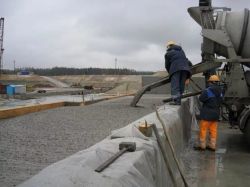The history of the replacement of monolithic foundations with prefabricated from foundation blocks arose in connection with the industrialization of the construction of the above-foundation part of the building.
At first, low-rise residential buildings were built by industrial methods, and the cobbled and chopped houses were replaced by prefabricated frame and panel houses. The construction of such houses was spent 25-30 days, of which the above-foundation part of the house was only 5-10 days. This discrepancy in the duration of the construction of certain parts of the building put the builders on the issue of the need to industrialize the erection of foundations.
In 1925, for the first time in the practice of building engineer. P. Rabotnov [1] proposed to replace labor-consuming butovye foundations of low-rise buildings with prefabricated blocks.
The first prefabricated foundations consisted of concrete columns with a section of 12x12 cm with a broadened lower part with a sole size of 50X50 cm. The distance between the poles was assigned depending on the magnitude of the load and ground conditions.
Simultaneously with the application of columnar prefabricated foundations began to introduce tape and mounted from the foundation blocks. So, in 1925 on the construction of a residential village "Dukstroy" near Moscow, prefabricated foundations were used from hollow ceramic blocks. The lower row of blocks was laid on a concrete preparation with a thickness of 20 cm.
At the beginning of the First Five-Year Plan, prefabricated foundations began to be used in industrial buildings together with prefabricated reinforced concrete structures of the ground part (columns, crossbars, purlins). For the first time, prefabricated foundations were used to build one of the multi-storey industrial buildings erected in winter conditions. The foundations of this structure were prefabricated reinforced concrete (reinforced concrete pillows pivotally connected to the frame racks).
In subsequent years, prefabricated foundations used a number of industrial plants: the Sharikopodshipnik (second stage), Frezer, cable, etc. The foundation for the column was made in the form of a shoe with slopes or ledges, with a nest in the middle, in which was installed Reinforced concrete column. The weight of such a foundation for the columns of the shops of the cable plant in Moscow was 2.4 tons.
Like all the first elements of prefabricated structures, this foundation (2, a) had too much reinforcement and therefore was not widely used. For other industrial buildings, in particular for the second stage of the same plant, prefabricated foundations were used in the form of the same shoes, but of a simpler shape (2, b) and with less reinforcement. These shoes were reinforced with only two grids - the top and bottom. The height of the glass was assigned taking into account the perception of normal force and bending moment.
Later, a reinforced concrete shoe of stepped form (2, c) was developed at the Central Scientific Research Institute of Industrial Structures (TSNIIPS). This type of foundation also had two meshes: the upper and lower and, in addition, the oblique rods and clamps, which are of the same order of magnitude. The shearing of the walls of the glass from the action of bending moments. On the basis of the tests carried out by the Central Research Institute for Nuclear Research, a method was developed for calculating and constructing such foundation shoes.
Thus, for industrial workshops with small crane loads, the first bulky, heavily reinforced fake shoe was replaced with light ones, but sufficiently reliable; The manufacture of these foundations in the field did not present any difficulties. The foundations of CNIIPS were applied in the construction of some industrial enterprises. For workshops with large crane loads, a technically rational prefabricated foundation was not found, so such workshops were erected on monolithic concrete-concrete or concrete foundations.
Since the 1930s, industrialization of multi-storey civil engineering began: large blocks of houses, buildings with reinforced concrete skeleton, etc. began to be erected. However, in these buildings many elements, including foundations, were not yet prefabricated.
In order to industrialize the construction of foundations, engineers Szchem and Chelbaev [2] proposed making foundations of reinforced concrete standard elements. The foundations of the engineering system of Syuch and Chelbaev were a lattice wall or separate pillars. The voids between the stones were filled with soil, and in the presence of a basement-brick laying half a brick thick or one brick. The advantage of this type of foundation is that it allows fuller use of the strength of the wall material. At the same time, he has a significant drawback: the lack of rigidity in the longitudinal direction with columnar foundations and insufficient rigidity in the lattice. Another significant drawback of the foundations of this type is the complex shape of the foundation elements and, as a consequence, the difficulty of their fabrication.
Somewhat later Ing. A.R. Sakk also with a view of more full use of strength of wall material proposed to arrange prefabricated foundations of solid concrete blocks with a thickness of 20-30 cm.
Каталог
The history of foundation development from foundation blocks in the USSR
Технические характеристики





